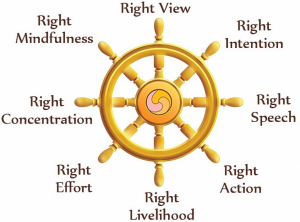The Noble Eightfold Path

The Noble Eightfold Path, also known as the Middle Way, is the Path to end all suffering. All eight elements of the Path begin with the word ‘Right’ (sammā), indicating the sense of wholesome, wise, ideal, or skillful way. The Path consists of:
1. Right View (sammā-ditthi) – also known as right understanding, right perspective, right outlook; the view and wisdom in accordance with Truth. It is the right way of looking at life, nature, and the world as they really are. It involves the understanding with reference to the human existence, moral law of karma, merit and demerit, the three characteristics of life (impermanence, suffering, and non-self), defilements (greed, hatred, and delusion), and the Four Noble Truths. The purpose of Right View is to clear one’s path of misunderstanding, confusion, and deluded thinking, and inspire one to lead a virtuous life. Right understanding is the keynote of Buddhism.
2. Right Thought (sammā-sankappa) – also known as right intention, right resolve, right conception, and right aspiration. It involves a mind free of whatever qualities that are wrong and immoral, such as lust, ill-will, hatred, selfishness and cruelty; to think toward non-attachment, renunciation, loving-kindness and harmlessness, as opposed to selfishness, ill-will, and cruelty; and to consider the plight of others with sympathy and understanding.
3. Right Speech (sammā-vaca) – to speak the truth, to speak in a way that is polite, pleasing, affectionate, kind, beneficial, harmonious, and with good intention; to abstain from lying, false speech, divisive speech, abusive language, harsh language, unkind words, tale-bearing, foolish babble, idle chatter, and saying things that are unbeneficial, unkind, or hurtful to others.
4. Right Action (sammā-kammanta) – also called right conduct: good conduct earned by not taking life, not stealing or taking what is not given, not committing sexual misconduct, not taking intoxicants; to be morally upright in one’s activities, not acting in ways that would be corrupt or bring harm to oneself or others.
5. Right Livelihood (sammā-ajiva) – to practice honest and wholesome professions; to acquire wealth through honest and ethical means; to avoid occupations that involve cheating on others or causing harm or suffering to anyone. Choose a work or profession that is morally satisfying or fulfilling, something that makes you “sleep well at night”. Any work that benefits others and does not violate moral precepts is right livelihood. Any work that involves killing or causing misery to others, such as trading in weapons, in poisons, in intoxicants, raising animals for their flesh or slaughter, or human trafficking, should be avoided. Some professions may be legal and acceptable to society, but if they violate moral precepts or the law of karma, they should be avoided.
6. Right Effort (sammā-vayama) – also translated as right endeavor, right diligence. It is the effort to do good and avoid bad; to prevent new evil from entering one’s mind; to remove all evil that is present; to develop and maintain wholesome conduct; to avoid and overcome unwholesome things; to suppress all evil thoughts; and to cultivate virtues that lead to enlightenment.
7. Right Mindfulness (sammā-sati) – also translated as right awareness and right attention: to be conscious of one’s own thought, action and speech; to have control of the senses; to act with clear comprehension; to keep one’s mind alert to phenomena that affect the body and mind, putting away greed and distress with reference to the world; not to act or speak due to inattention or forgetfulness; to remain focused on the body, on the feelings, on the mind, and on mental qualities; not to allow oneself to be overcome by discontent, fear, anxiety, physical and mental pain; and to be aware of the consequence of one’s own action. In the practice of right mindfulness, the mind is trained to be open, quiet, and alert, and contemplating on the present.
8. Right Concentration (sammā-samadhi) – also known as right meditation: to cultivate the mind in the proper way, to practice the right method of meditation. The goal is to reach a state of meditative absorption, known in Pali as ‘jhāna’, leading to eventual attainment. As such, the practitioner concentrates on an object of attention until reaching full concentration and a state of meditative absorption. Traditionally, the practice of one-pointed concentration, known in Pali as ‘samādhi’, can be developed through mindfulness of breathing, through visual objects, and through repetition of a mantra. Jhāna is used to suppress the five hindrances in meditation (sensual desire, ill-will, boredom, restlessness, worry, doubt) in order to enter into samādhi, or perfect concentration. Jhanā is an instrument used for developing wisdom by cultivating insight and by using it to examine the true nature of phenomena with direct cognition. This leads to cutting off the defilements, realizing the Dharma and, finally, to self-awakening. During the practice of right concentration, the practitioner will need to investigate and verify his or her right view. In the process right knowledge will arise, followed by right liberation. Any singleness of mind equipped with these seven factors—right view, right resolve, right speech, right action, right livelihood, right effort, and right mindfulness—is called right concentration.
All eight steps of the Path should be practiced simultaneously.
Buddhism is based on personal experience. True wisdom can be acquired by practice only. Instead of beliefs and dogmas, the importance of practice is emphasized. The validity of Buddhist teachings can be practiced and verified by experience. Rational understanding is encouraged, not blind faith.
(Credit to Surin Jung)
